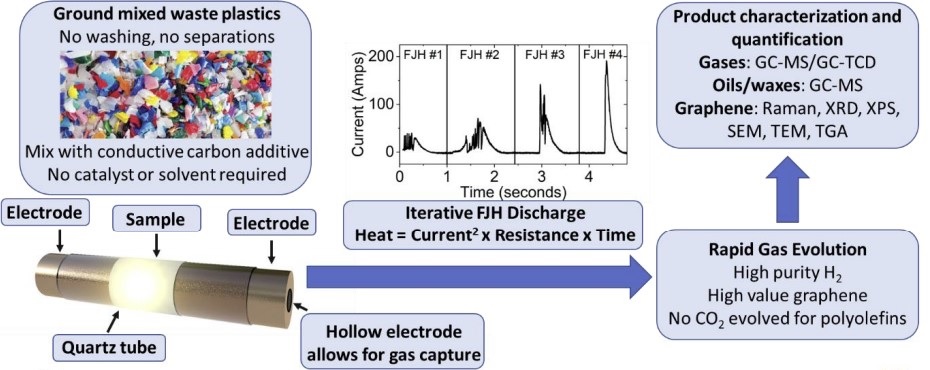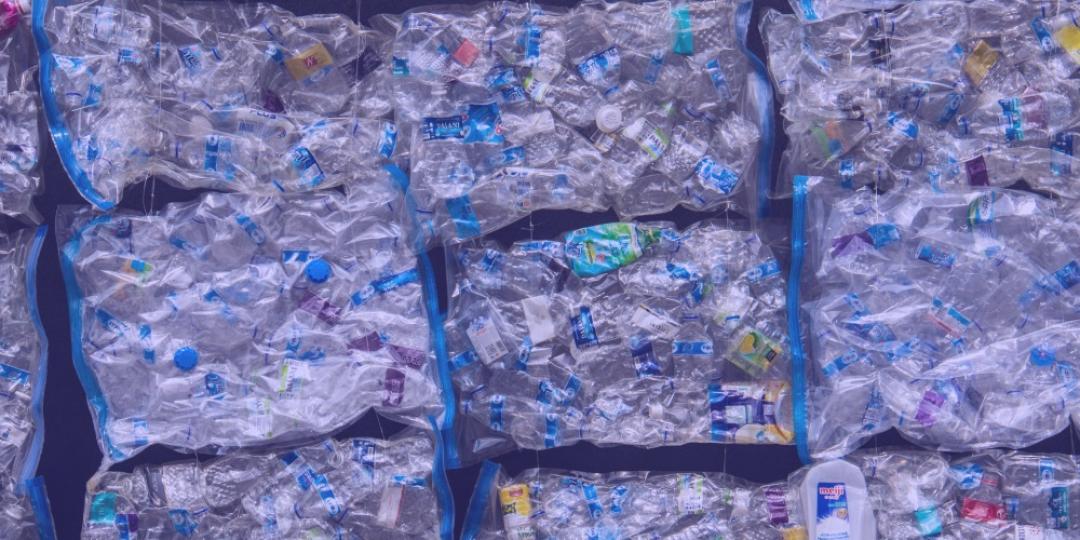by Paul Day, Reuters
Rapid flash joule heating (FJH) of waste plastics produces large quantities of hydrogen gas and high-purity graphene, researchers at Rice University in Houston, Texas, have found, a method that could turn the nascent hydrogen industry on its head if proved to be scalable.
FJH discharges current through a carbon-based product to increase the temperature up to 3,000C within a tenth of a second. The sudden heating reorganizes the product’s chemical bond, converting the carbon-carbon bonds to graphene and releasing the hydrogen.
“We just bore a hole in one of the electrodes and the hydrogen comes spurting out,” says James Tour, Professor of Chemistry, Computer Science, Materials Science, and NanoEngineering at Rice University, founder of 14 companies, and author of over 785 research publications.
The U.S. Department of Energy’s (DOE’s) ‘Earth Shot’ hydrogen strategy aims to create an industry that can make one kilo of hydrogen for $1 within one decade.
“This method solves your 1-1-1 challenge. And we’re at much less than $1,” says Tour.
“You take plastic off the street, you form a material that allows you to use less building material, because you're strengthening it with the graphene, and you get hydrogen as your byproduct. It's a tremendous way to go.”
One Tour-founded company, Universal Matter, has headquarters in Canada, the United States, and Britain and is focused on producing graphene from the process. The company aims to have a demonstration plant in Burlington, Ontario, by the end of 2023.
Tough, flexible, and light
Turbostratic graphene, through the FJH process and without the use of solvents or reactive gases, can be produced from a broad range of carbon-based feedstock material, including recycled plastics, coke, and petroleum, as well as biomass and discarded food waste, Universal Matter says.
Graphene is a tough, flexible, light, nanomaterial with a high resistance. An individual sheet is 200 times stronger than an equally thin piece of steel, says Ford Motor Co., one of the only companies to use graphene at an industrial scale.
“The graphene is mixed with foam constituents, and tests done by Ford and suppliers have shown about a 17% reduction in noise, a 20% improvement in mechanical properties, and a 30% improvement in heat endurance properties, compared with that of the foam used without graphene,” the company said in a statement.
Worth $60,000 to $100,000 per ton, graphene may prove to be invaluable for automakers such as Ford as a reinforcing material in automobile production.
Rice University chemists, led by Tour, Rice doctoral alumnus Kevin Wyss, and Ford researchers have been using the flash joule heating process to turn plastic parts from old vehicles into graphene in a process detailed in a joint study published in a new Nature journal, Communications Engineering.
An average SUV contains up to 350 kg of plastic that, without upcycling to graphene, is destined for a landfill.

Some 12-35% of an end-of-life (ELV) vehicle, after the recovery of metallic content, is dumped accounting for an estimated 5% of global industrial waste, according to the study of which Wyss is a lead author ‘Upcycling end-of-life vehicle waste plastic into flash graphene.’
The study notes that the European Union implemented a directive to ensure the recovery of ELV raw materials achieves a minimum of 95% of vehicle weight by 2015, however almost all member states failed to meet these guidelines since recycling of ELV waste plastic is expensive due to the high cost of feedstock segregation.
If companies such as Universal Matter can scale production using the FJH process, something Ford is also studying through a new research team in Brazil, graphene may prove to offer a compelling solution to the build-up of plastic waste worldwide.
And, with hydrogen as a by-product, the process may offer twice the value.
“It certainly seems scalable ... Rather than just let the hydrogen escape, you might as well use it for energy,” says Tour.
Turning to gas
Life-cycle assessments demonstrate a 39-84% reduction in emissions compared to steam methane reformation and electrolysis production of hydrogen “suggesting the flash H2 to be an economically viable, clean H2 production route,” a separate Rice University study, led by Tour and Wyss, claimed in September.
“The co-production of hydrogen with high-value materials could afford an economic basis to achieve this goal, and thereby displace steam methane reforming,” according to ‘Synthesis of clean hydrogen gas from waste plastic at zero net cost’.
“Rapid FJH of waste plastic can be performed with no added catalyst to deconstruct polyolefins, polyesters, and mixed waste plastics, affording high yields of hydrogen … along with high purity graphene as a value-added byproduct. Based on the sale of the graphene byproduct of this FJH H2-production process, the hydrogen produced by this process has negative production cost.”
The study, presenting a worst-case scenario, assumed graphene could be sold at $3 per kg, compared to current market value of some $60 per kg, which leaves the preliminary cost of FJH-produced hydrogen at the negative value of -$4,24 per kg.
Scaleup of the process, however, is fraught with potential problems, including a risk of combustion or ignition of the gases produced, but Tour is confident that the benefits, both for the recycling of plastics and the production of graphene and hydrogen, make it worth the work.
“We've already solved it from an academic perspective, now it is ready to go through the transition. The transition is called the ‘Valley of Death’ for a reason as it's not easy to do,” says Tour.
“However, Universal Matter has demonstrated the scaling in their pilot facility and then it's just a matter of capturing the gas.”















